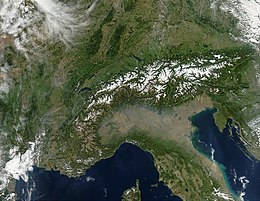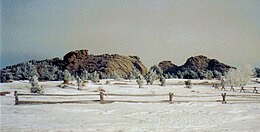Mountain chain

Amountain chainis a row of highmountain summits,a linear sequence of interconnected or related mountains,[1]or a contiguous ridge of mountains within a largermountain range.The term is also used for elongatedfold mountainswith several parallel chains ( "chain mountains" ).
While in mountain ranges, the term mountain chain is common, in hill ranges a sequence ofhillstends to be referred to aridgeorhill chain.
Elongated mountain chains occur most frequently in theorogenyof fold mountains, (that are folded by lateral pressure), andnappebelts (where a sheetlike body of rock has been pushed over another rock mass). Other types of range such ashorst ranges,fault blockmountain ortruncated uplandsrarely form parallel mountain chains. However, if a truncated upland is eroded into a hightable land,the incision of valleys can lead to the formations of mountain or hill chains.
Formation of parallel mountain chains
[edit]

The chain-like arrangement of summits and the formation of long, jaggedmountain crests– known in Spanish assierras( "saws" ) – is a consequence of their collective formation bymountain building forces.The often linear structure is linked to the direction of these thrust forces and the resultingmountain foldingwhich in turn relates to thefault linesin the upper part of theEarth's crust,that run between the individual mountain chains. In thesefault zones,the rock, which has sometimes been pulverised, is easily eroded, so that largerivervalleys are carved out. These, so calledlongitudinal valleysreinforce the trend, during the early mountain building phase, towards the formation of parallel chains of mountains.
The tendency, especially of fold mountains (e. g. theCordilleras) to produce roughly parallel chains is due to their rock structure and the propulsive forces ofplate tectonics.The uplifted rock masses are either magmaticplutonic rocks,easily shaped because of their higher temperature, orsedimentsormetamorphic rocks,which have a less robust structure, that are deposited in thesynclines.As a result of orogenic movements, strata of folded rock are formed that are crumpled out of their original horizontal plane and thrust against one another. The longitudinal stretching of the folds takes place at right angles to the direction of the lateral thrusting. Theoverthrustfolds of anappebelt (e.g. theCentral Alps) are formed in a similar way.
Although the fold mountains, chain mountains and nappe belts around the world were formed at different times in the Earth's history, all during their initial mountain building phases, they are nevertheless morphologically similar. Harder rock forms continuousarêtesor ridges that follow thestrikeof the beds and folds. The mountain chains or ridges therefore run approximately parallel to one another. They are only interrupted by short, usually narrow,transverse valleys,which often formwater gaps.During the course of Earth history,erosionby water, ice and wind carried away the highest points of the mountain crests and carved out individual summits orsummit chains.Between them, notches were formed that, depending onaltitudeand rock-type, form knife-edgedcolsor gentlermountain passesandsaddles.
Dominant rocks and mountain forms
[edit]
Nappe or fold mountains, with their roughly parallel mountain chains, generally have a commongeologicalage, but may consist of various types ofrock.For example, in the Central Alps,graniticrocks,gneissesand metamorphicslateare found, while to the north and south, are theLimestone Alps.TheNorthern Limestone Alpsare, in turn, followed by softflyschmountains and themolassezone.
The type of rock influences the appearance of the mountain ranges very markedly, becauseerosionleads to very different topography depending on thehardnessof the rock and itspetrologicalstructure. In addition to height and climate, other factors are thelayeringof the rock, itsgradientandaspect,the types ofwaterbodyand the lines ofdislocation.For hard rock massifs, rugged rock faces (e.g. in theDolomites) and mightyscreeslopes are typical. By contrast, flysch or slate forms gentler mountain shapes andkuppenor domed mountaintops, because the rock is not porous, but easily shaped.
See also
[edit]References
[edit]- ^Whittow, John (1984).Dictionary of Physical Geography.London: Penguin, p 87.ISBN0-14-051094-X.
Literature
[edit]- Wissen heute: Geologie.Kaiser-Verlag, Florence/Klagenfurt, 1995
- Der geologische Aufbau Österreichs.Geologische Bundesanstalt, Springer-Verlag Vienna/ New York
- PanGeo,Erdwissenschaften in Österreich.Conference proceedings, 200 pp., Sessions on the Neogene, TRANSALP I and II. Univ. Salzburg, 2005
- Fischer-Lexikon Geographie,pp. 101–129, Frankfurt, 1959
- Großer Weltatlas, Enzyklopädischer Teil(mountain building, folds and faults, the rock cycle). Publ. ÖAMTC, Vienna, ~1980
- André Cailleux:Der unbekannte Planet: Anatomie der Erde.Kindlers Universitätsbibliothek, Munich, 1968, Chapters 1 and 3
- Gebirge,in: Lueger, Otto:Lexikon der gesamten Technik und ihrer Hilfswissenschaften,Vol. 4 Stuttgart, Leipzig, 1906, pp.316-317.
